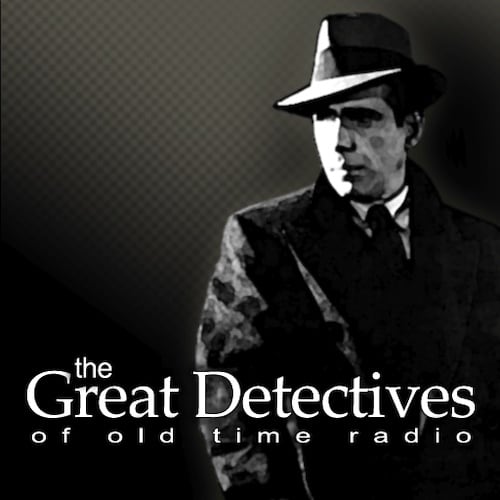Over the next three weeks, we’re going to count down the top five radio detective programs of three distinct eras during the Golden Age of Radio. The eras are the World War (1939-45), the Post-War (1945-51), and the Declining Years (1952-62).
From the outset, let’s keep in mind three things.
First, the rankings are based on the surviving programs. Right away, that is limiting. If we had more circulating episodes of some programs (or any episodes of programs that are completely lost), no doubt they would rank higher or might not be in the list all. But we work with what we have.
Second, there were detective programs prior to 1939. However, there’s not enough programs with a meaningful number of surviving episodes to allow for helpful comparison so we won’t be ranking them.
Third, many programs’ runs crossed multiple eras. Programs like Nick Carter, Mister Keen, Tracer of Lost Persons, and Mr. and Mrs. North aired during all three eras. For the purposes of our rankings, we’ll only evaluate the program for what we have of its run during the given era. It’s also possible for a series to be ranked in more than one era.
World War II Era Rankings
While there are more recordings of programs during World War II available than pre-War, many recordings are scarce. So many series from that era are lost or have left little evidence of their existence. This is partially due to the materials used for transcription disks being important for the war effort.. Still there are enough shows that have enough information for us to compare them even if we’re only basing that comparison on a few circulating episodes.
That said, let’s get on with ranking the top 5 World War II era detective programs:
5) Mister Keen, Tracer of Lost Persons
Network: CBS
Star Bennett Kilpack
The longest-running radio detective series of all-time was in transition during the War. It was moving from being about what the title implies to solving murder cases each week. While the series has its flaws (over-the-top soap operatic acting, constantly repeating characters names), it has undeniable charm. Mister Keen is mostly true to his reputation as a “kindly investigator.” The series is fun to listen to, with reliable and lovable performances from the leads.
Network: NBC
Stars: Joseph Curtain and Alice Frost
When most people think of husband and wife detective teams, they think of The Thin Man. Over radio, during the War, Mr. and Mrs. North was the better series. Curtain and Frost have great performance chemistry. The scripts are witty and light. The mysteries are fun. They also have a different dynamic than other shows, where the wife was the husband’s Watson. Both Norths are capable detectives and either one can end up solving the case. It’s a fun dynamic that makes for an interesting listen.
Networks: CBS, Blue Network, NBC
Star Herbert Marshall
The Man Called X took its titular hero and threw him into the heart of wartime action. During the war, Ken Thurston got into all sorts of espionage mysteries, even getting into Berlin just ahead of the allies. The mysteries were well-written, with plenty of action and suspense. Comic relief was dispensed by Pegon Zellschmidt (Hans Conreid, later Leon Belasco.)
Network: Mutual
Star: Lon Clark
Nick Carter originated as the lead character in a series of dime novels in the 1880s and had a long life in print and other media, including a three-film series starring Walter Pidgeon from 1939-41. The character’s radio program is perhaps the character’s most memorable form. Nick Carter is a master detective who has put away so many criminals it’s a lengthy task to go through even a portion of his files. The radio series had one of the most memorable openings of any program during the golden age of radio, with frantic knocking on the door. A woman answers, “What’s the matter, what is it?” A man answers, “It’s another case for Nick Carter, Master Detective!”
At a time before the coming of the hard-boiled private eye to radio, Nick Carter’s cases packed a bit more punch with more peril and excitement involved. He’d often pull off improbable escapes. They weren’t quite on the level of a 1940s Batman serial where Batman got away by pulling a full-sized acetylene torch out of his unity belt once, but they were a bit out there. The mysteries had a bit of pulp fiction flavor to them.
Carter did mostly half-hour episodes, but it also broadcast 100 serialized episodes for over twenty weeks. The series rarely touched on the War itself and provided a great diversion for folks at home.
1)The New Adventures of Sherlock Holmes
Networks: Blue Network, Mutual
Star: Basil Rathbone
Basil Rathbone and Nigel Bruce had starred as Sherlock Holmes and Doctor Watson in two films already when they starred in the first series of New Adventures over the Blue Network in 1939. They did a total of three seasons that averaged twenty-four weeks each. Then came the Universal Sherlock Holmes features that placed Holmes and Watson in the World War II era and a new series over Mutual that would release a new episode every single week for two years. Through both networks runs, the duo performed both works from Doyle’s original canon and added true new adventures. The tone would vary from week to week: from the comedic to the horrific and the poignant. Through it all, Rathbone and Bruce rolled with the punches and turned out solid performances each week .
Bruce not only played Holmes’ sidekick but an older Watson who had retired to America and would play host to the pitchman for whatever product was sponsoring them in a given season. It adds a nice touch of charm to a well-acted and written series worthy of the world’s greatest consulting detective.

2 comments for “The Top 5 World War II Era Radio Detective Programs”